Should You Buy the Synology DS423+ or Terramaster F4-423 NAS Drive
So, comparing the Synology DS423+ vs Terramaster F4-423 NAS is easier said than done – we are talking about two brands that have very different priorities when it comes to the solutions they provide. But, I am getting ahead of myself. If you have just made the decision to switch from public cloud services (Google Dive, DropBox, etc) towards your own private NAS server, then chances are you might have been a little surprised by the price tag of the average NAS. Because subscription services are months subscription-based that are spread over years and years, requiring little-to-no extra physical hardware on the client side (you!), a fully deployed NAS server with HDDs and/or SSDs can seem quite the investment up from for a small home or business user. Thankfully, the NAS market has evolved quite alot over it’s 20+ years of commercial availability, resulting in scaled solutions/brands that do a reasonable job of fulfilling their portfolio with NAS drives that allow you to make more targeted purchases (i.e you pay for the things you want to use and save on the bits you don’t). Now, in the world of private servers, the big brand that everyone recommends as your entry point into NAS is Synology. This brand has an extensive portfolio of solutions, trades more on it’s 1st party software than hardware and despite its ‘generally higher than most pricetag’ is considered the top brand in NAS. However, that higher price point and prioritising software over hardware has always been something of an annoyance to some of the more DiY or technically-versed buyers. These are users that want to adapt a solution themselves, want value for money and don’t want to be locked in too much to a single ecosystem. Into this debate, arrives Terramaster. Terramaster is a smaller company, that trades more on it’s hardware than its software – whilst still keeping things affordable. Chances are you came to this article because you have been comparing the recently released Synology DS423+ and the Terramaster F4-423 from 2022, trying to figure out how a Synology that arrives with arguably much lesser/older hardware is STILL more expensive than the 6 months old Terramaster with pretty current Prosumer hardware on board. So, that is the purpose of today’s comparison, to lay out how they differ, and how they are the same and ultimately help you decide which solution is best for you and your data in 2023!
Synology DS423+ or Terramaster F4-423 NAS – Internal Hardware
Now, the hardware inside the Terramaster F4-423 is definitely the more modern and, frankly, in terms of the traditional hardware available in the default model of each, the Synology hardware is certainly showing its age a tiny bit. Both of these are 4-Bay SATA 3.5/2.5″ drive systems that support multiple RAID systems (RAID 0.1.5.6) and an internal Fluid/Flexible RAID (SHR or TRAID, respectively) for better scaling of storage over time. As well as traditional storage, the also feature two M.2 NVMe 2280 SSD bays. Now, after this, the comparisons get a little all over the place! For a start, the M.2 NVMes on the Synology and Terramaster can be used for caching AND raw storage pools (i.e to store data the same as the HDD bays). Both systems support the choice of BTRFS or EXT4 as the file system at initialization – though traditional file system performance (regardless of the hardware difference) seems better on the Synology NAS. They both arrive with DDR4 Memory, but the Terramaster arrives with 4GB of memory by memory by default, with the maximum supported memory being 16GB on the Terramaster and the Synology DS423+ can only being upgradable to 6GB (CPU recommendation is 8GB, but the initial 2GB in the DS423+ is soldered to the board and only has 1x available SODIMM slot).Before we dip into the main CPU differences, here are the internal specifications side-by-side:
| Model | Synology DS423+ NAS
|
Terramaster F4-423 NAS
|
| Number of SATA Bays | x4 | x4 |
| Supported RAID | RAID 0, 1, 5, 6 and SHR (Flexible) | RAID 0, 1, 5, 6 and TRAID (Flexible) |
| Number of M.2 NVMe Bays (Gen) | 2x NVMe M.2 2280 Gen 2 | 2x NVMe M.2 2280 Gen 3×1 |
| M.2 NVMe Deployment? | Caching or Storage Pools | Caching and/or Storage Pools |
| CPU | Intel Celeron J4125 CPU | Intel Celeron N5105 CPU |
| Cores | 4-Core | 4-Core |
| Frequency | 2.0Ghz-2.7Ghz | 2.0Ghz-2.9Ghz |
| Integrated Graphics | Yes | Yes |
| Default Memory | 2GB DDR4 SODIMM (Fixed) | 4GB DDR4 SODIMM |
| Max Memory | 6GB SODIMM – 1 SLOTS | 16GB SODIMM – 2 SLOTS |
| Storage Expandability | No | Yes, with Terramaster DAS systems connected |
| Power Supplier | 100W | 90W |
The CPU inside the Synology DS423+ NAS is an Intel J4125, released at the end of 2019 and although was a very popular CPU at the time (with many brand, including Terramaster featuring it in their systems), it has now seen a couple of newer generation quad-core Celeron’s for servers released in that time – the N5105 and J6412. Now the pandemic and its effect on the supply chains through 2020/2021 did make things rather messy in the Celeron family (at one point the N5105/N5095/N5095A were all running at the hardware/OEM level), but things have levelled out now and in terms of this scale of storage, most other brand have moved onto the N5105 or J6412 CPU. As you can see in the chart below (N5105 highlighted in particular, as it is the best of the three), in the release time between the Intel J4125 and N5105, there have been multiple improvements in architecture, efficiency and scalability of the CPU inside the Terramaster NAS.
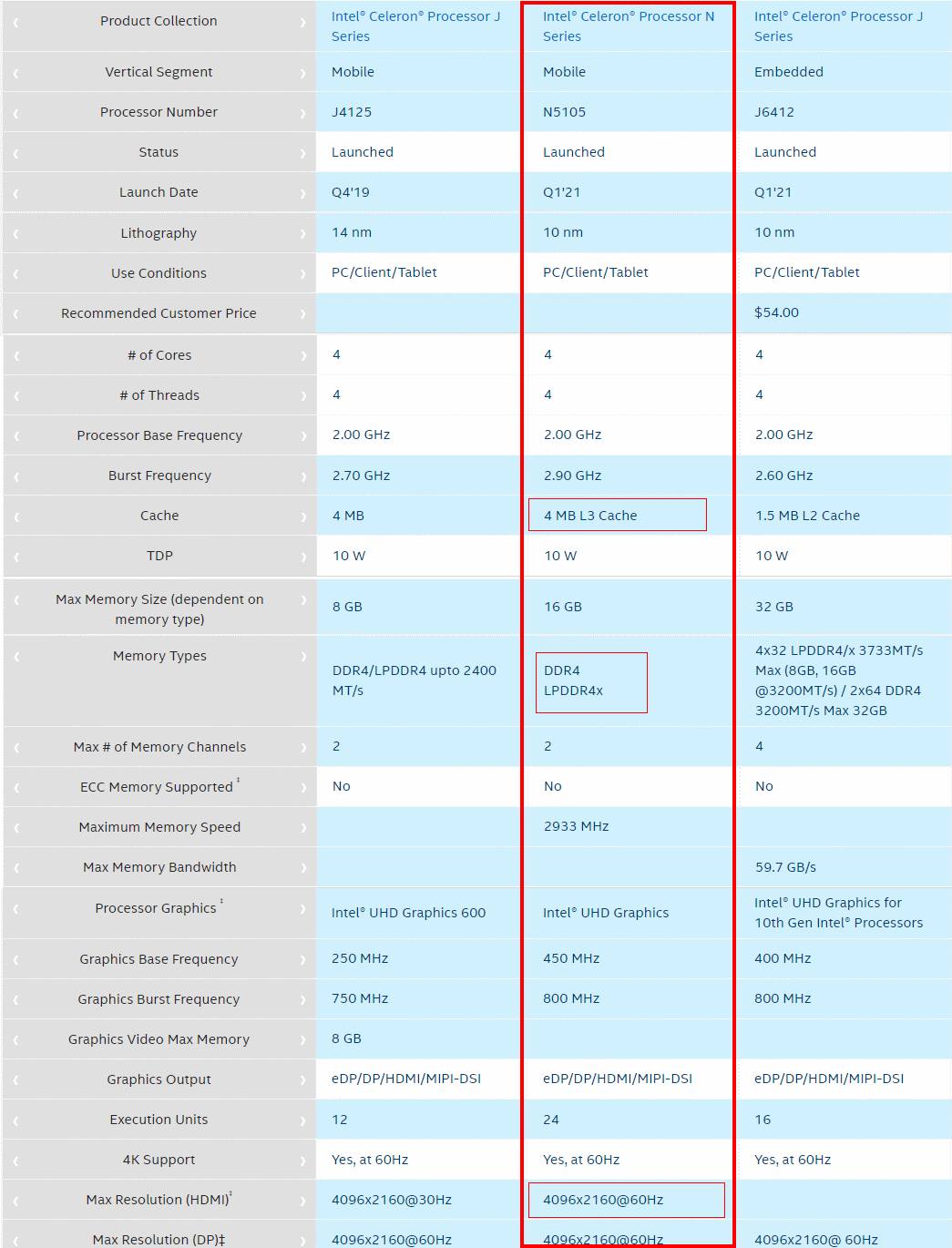
However, with the Dec 2022 released DS923+ NAS arriving with an AMD Embedded Ryzen Dual Core R1600 CPU (no integrated graphics, half the cores, higher TDP/Power use potential – but the same threads and higher clock speed), right now the DS423+ is still the go-to NAS for Prosumers/Plex Media users wanting a 4-Bay Synology NAS with an integrated graphics CPU for things like transcoding and conversion of HEVC/H.265 media on the server side in the x23 generation. So, in THAT context, the hardware in the DS423+ still needs to be compared against that of the F4-423 and, sadly, is found a little lacking 2.5yrs on. The general hardware, performance and throughput of the Synology DS923+ NAS is still excellent, but if you are considering a NAS server for it’s hardware so you can run 3rd party processes and want value for money, the Terramaster F4-423 NAS is the hardware favourite here!
Synology DS423+ or Terramaster F4-423 NAS – Design
This is going to be a real area of contention for some users who are either in close proximity to the NAS they buy or are a little more sensitive to noise. I say this because the Terramaster F4-423 NAS has great hardware, but the design is a little less impressive. The chassis (arriving in a combination of plastic and metal internal structure) is a little more dated in design than the Synology DS423+. This is further underlined when you see that the F4 series used the same chassis as the F5 5-Bay (it just removes the additional SATA Bay and bay, but maintains the same width. The result is a NAS that is a bit wider than the DS423+. Additionally, the chassis feels a little more cost-effective/budget on the Terramster than the Synology. Synology has been using this 4-Bay chassis since around 2017 in this product series and it still looks pretty modern by comparison.
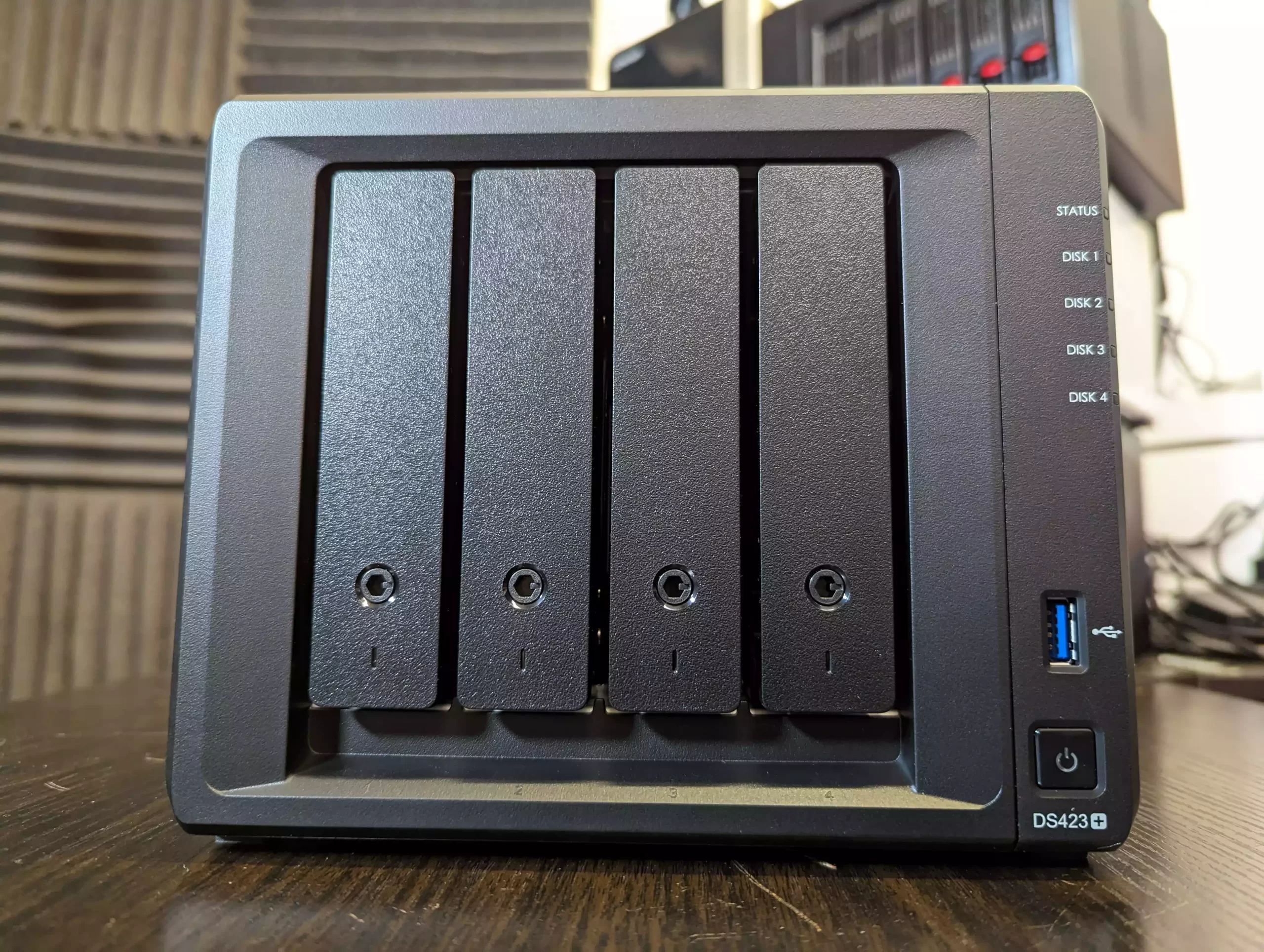 |
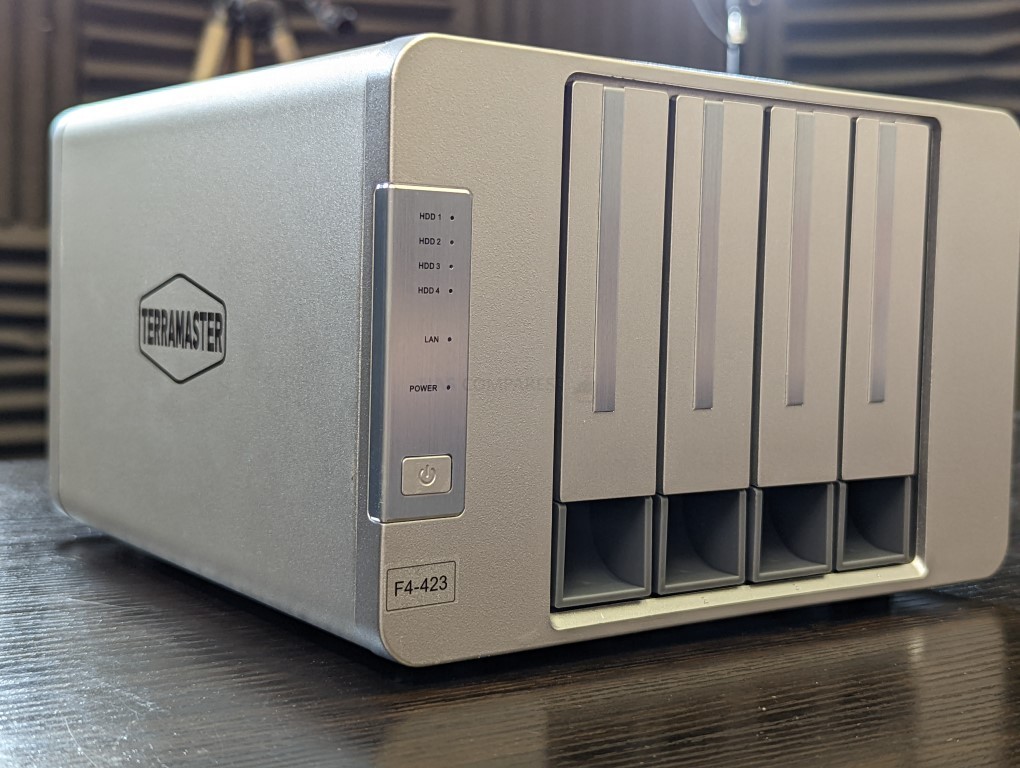 |
The rear of these two chassis reveals that they both arrive with two active cooling fans. These fans are designed to maintain the best possible internal running temperature, as NAS servers of this scale rarely have CPU fans and rely on well-placed heatsinks and strategically placed airflow throughout the system to keep the components running at the most efficient temperature 24×7. The fans on the Synology are a little more subtle, but are also a fraction larger (92mm sq each on the Synology vs 80mm sq on the Terramaster). You might think this means that the Synology is the noisier of the two. However, in reality, the Terramaster is the tiniest pinch louder in ambient noise when in operation. This is due to several factors. The first is that the fans are part of a larger external block on the rear of the device (as opposed to being contained within the larger casing). The other reason is that the Terramaster NAS chassis contains more metal (on the base and a much more structured use of aluminium internally by comparison to the Synology which features alot more plastic in it’s framework and external. The noise difference is very, VERY small, but will be increased a pinch more when using more industrially designed HDDs above 10TB (that have more platters thanks to helium-sealed drive technology, dedicated 7200RPM) because of the increased vibration and resulting hum, clicks and whirrs. It’s a very small difference, but the particular noise sensitive will notice this.
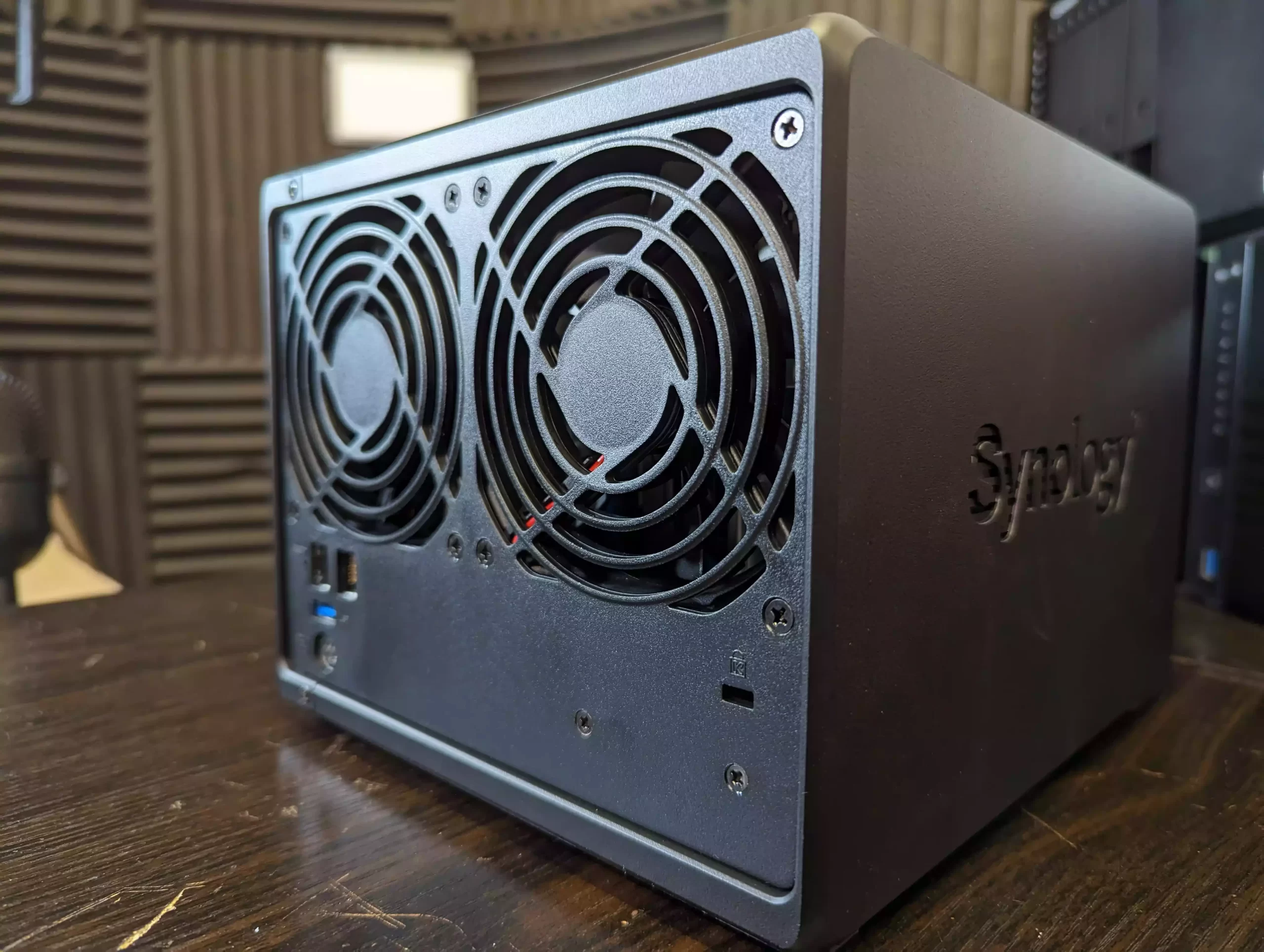 |
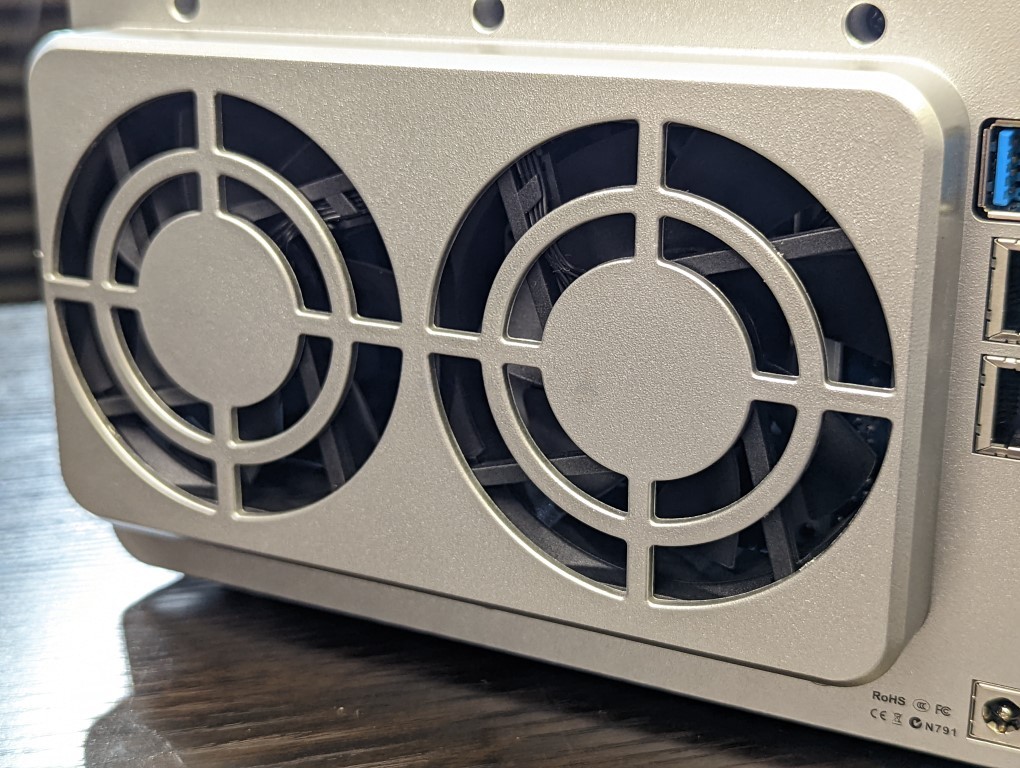 |
The final thing to discuss in the chassis design of the Synology DS423+ and Terramaster F4-423 is velitation and passive cooling. Both of these NAS drive’s have ventilation places around their casing to work in conjunction with those active cooling fans. The Synology arguably does a better job of things on this too, as not only do the sides of the casing have the familiar brand logo in a vented design, but the M.2 slots have ventilated covers on the base and even the trays have a bit more airflow between the drives. The Terramaster has a small amount of ventilation on the front between the bays, but the bulk of the passive ventilation on the F4-423 is on the base of the chassis (under the storage bays). Although the overall impact of these passive ventilation methods is still going to be heavily dependent on the fans and internal heatsinks, the design of the Synology DS423+ chassis just seems a little more thought out.
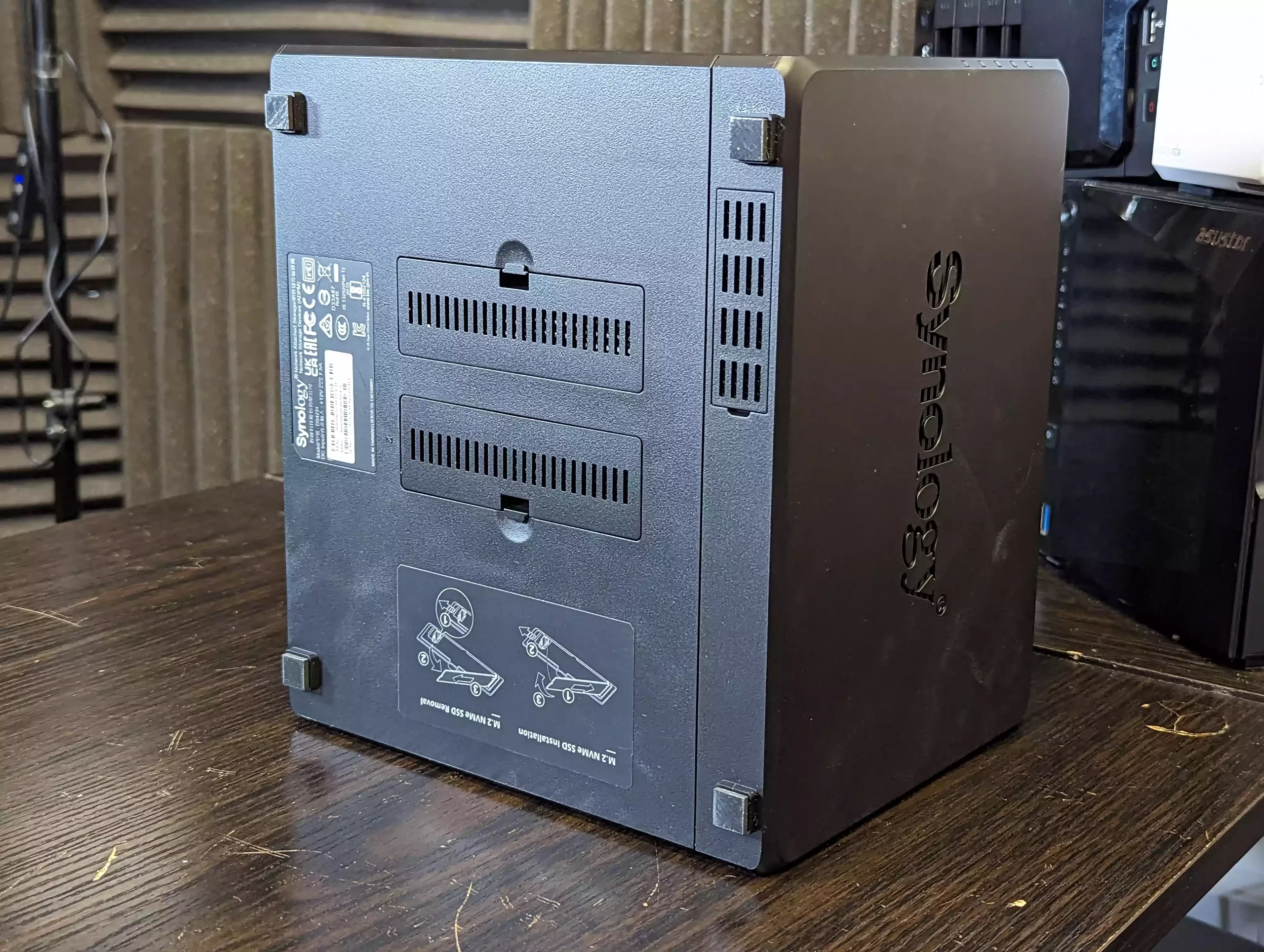 |
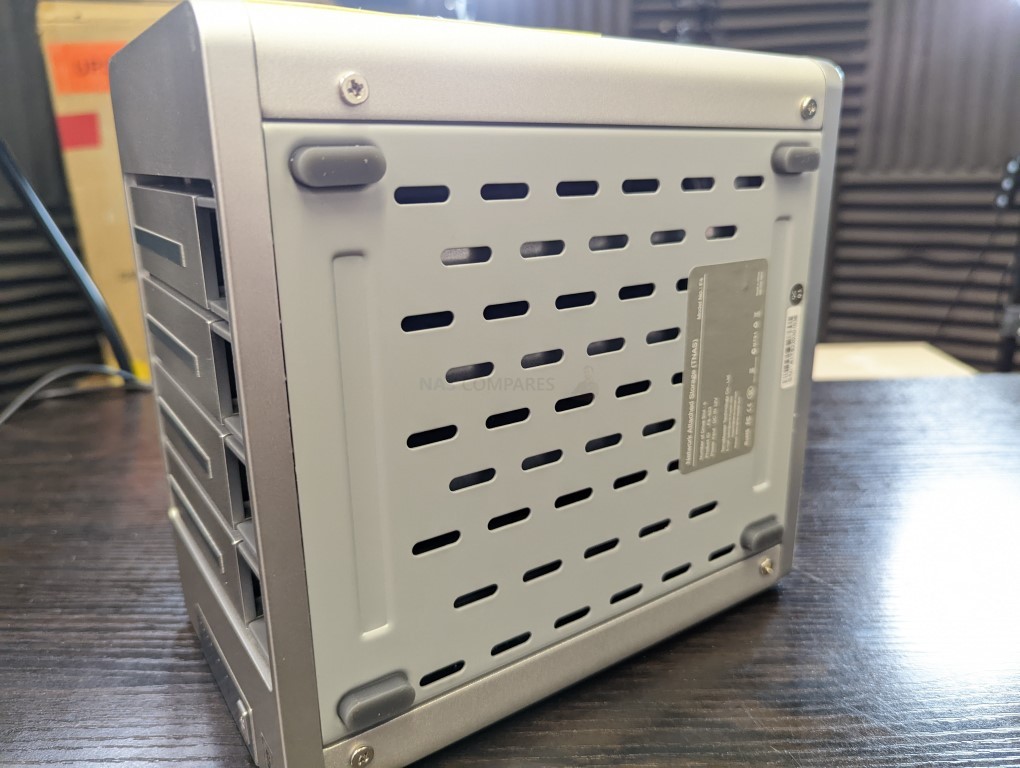 |
Overall, the SYNOLOGY design wins overall, thanks to its better middle ground design between airflow, chassis size and noise compared with the Terramaster F4-423. Although neither brand provides its solutions in a variety of colours, the Black and largely square Diskstation chassis will blend in better in most environments too. Next, let’s discuss network connectivity.
Synology DS423+ or Terramaster F4-423 NAS – Ports and Connections
The connections that a NAS arrives with will heavily dictate the access speed and performance between it and your client devices. This becomes especially true when your NAS is going to be accessed by a large number of users/tasks at any given time, as the result is the bandwidth (the maximum potential connection speed) being shared between them all. Now the 2023 released DS423+ arrives with arguably very dated connectivity. This is especially true when compared with the 2022 released F4-423. Here is how they compare off the bat:
| Model | Synology DS423+ NAS
|
Terramaster F4-423 NAS
|
| Default Network Connections | 2x 1GbE | 2x 2.5GbE |
| Network Upgrade / PCIe Slot | No | No |
| USB 3.2 Gen 2 (10G) | 0 | 2x |
| USB 3.2 Gen 1 (5G) | 2x | 0 |
| USB 2.0 | 0 | 0 |
| eSATA | 0 | 0 |
| HDMI | No | 1x HDMI 2.0 (Command Interface ONLY, no GUI) |
| Audio In/Out | No | No |
So, alot of differences here to unpack. Some things are quite brand specific that are sadly absent here, such as the Synology DS423+ NOT featuring an eSATA port that is used for the DX517 JBOD expansion 5-Bay – so the DS423+ cannot have it’s available storage expanded in its lifespan outside of the initial 4 bays. The same goes for the Terramaster F4-423 having an HDMI port for local (command level) access with a USB Keyboard, something Synology have never provided outside of very specific Surveillance solutions, but its use is EXTREMELY limited and there is no GUI available (compared with the likes of QNAP HD Station and Asustor Portal). But the areas we CAN compare are USB connectivity and the network connectivity. The USB ports on the Synology are USB 3.2 Gen 1 (5Gb/s) and have limited support in the system software (DSM), but are largely used for external storage drives and UPS devices; that’s about it (you can assign them to a VM). The USB ports on the Terraamster on the other hand are USB 3.2 Gen 2 (10Gb/s), so twice as higher bandwidth than the Synology, as well as supporting a larger number of USB devices (so storage and UPS’ like the Synology, but also devices such as printers, scanners, network adapters and WiFi dongles), as well as several of the Terramaster DAS devices to use as expansion chassis. The next big difference is that the Synology arrives with two 1GbE Network ports (these can be combined via LAG/Port-Trunking/Multi-Channel to 2GbE with a smart switch) and the Terramaster has 2x 2.5GbE ports (which can also be combined too). This means the Terramster has a significantly higher external network bandwidth available. You will still need to be using a greater than Gigabit Router or Switch in order to take advantage of these speeds, but given that now you can get USB-to-2.5GbE adapters for as little as £20, this is getting easier to take utilize. If you are in a pure 1GbE network environment and have zero intention to upgrade to 2.5G or 10G in the next few years, you can largely ignore this advantage, but given that an increasing number of day-to-day devices are arriving with 2.5G at the same price as 1G (ISP Routers with WiFi 6, Prosumer routers, Switches, PC Motherboards, etc), its tough to overlook that extra external connectivity that the F4-423 provides here. Equally, the DS923+ NAS mentioned earlier from Synology features a PCIe network upgrade slot for adding 10GbE – something SORELY missed on the DS423+.
Synology DS423+ or Terramaster F4-423 NAS – Software
On the subject of NAS software, this is where the Synology NAS is exceedingly strong! Although the Terramaster NAS platform has seen a huge number of improvements in recent years (TOS version 5.1 was launched at the start of 2023), with new apps, services and modes included, Synology and DSM is still considered the dominant force in NAS software. The Synology DSM platform feels alot more responsive, has a huge number of first-party applications (As well as mobile and desktop client applications too) and although 3rd party application support is available in a number of their tools, the real strength in the Synology software is how the brand releases it’s own 1st party alternatives (allowing you to create a single ecosystem of tools for your NAS storage and network). Use Skype or Whatsapp? Then you can use Synology Chat. Use DropBox or Google Drive for team sharing and local storage synchronization? Use Synology Drive. Use Google Docs, Google Cloud Space and Google Workspace? Then use Synology Collaboration Suite and Active Backup. Plex or Emby? Use Synology Video Station instead, as it has metadata scraping and no subscription. Even high-end business is covered. Synology Virtual Machine Manager instead of Hyper-V or VMware, Surveillance Station instead of Milestone – the list is huge AND crucially, all of these apps are compatible with 3rd party tools too, whether it is to sync with them to create a bare-metal NAS backup, or to open and continue from your 3rd party setup into a 1st party setup. Below is my full review of Terramater TOS 5 and Synology DSM:
Now, this isn’t to say that the Terramaster TOS system is not good, it is better than it has ever been, very responsive, features improved 1st party apps in its latest version (new AI-powered Photo recognition tool Terra Photos, Surveillance Center application, VM support, improved muti-tier and multi-site backup manager and more), but the apps and the GUI does not feel quite as polished as the Synology platform and you definitely get the feeling that a larger % of the cost of a terramaster goes towards the hardware than the software. If you are only planning on using the NAS as a target drive for your 3rd party tools, then the Trramaster will support you well. Just know that the total Hardware+software type buyer will want to opt for Synology and the award-winning DSM. Alternatively, if you are NOT interested in using the software included with your NAS, there is always the option to install TrueNAS – Somthing that is surprisingly easy on the Terramaster NAS (see video below):
Synology DS423+ or Terramaster F4-423 NAS – Conclusion and Verdict
Overall the choice between the Synology DS423+ and the Terramaster F4-423 NAS comes down to too main factors. 1) Do you prioritize Hardware or Software? As the Terramaster is the best for the former and the Synology is much better for the latter! 2) What do you expect from the NAS system? If you want a system that is designed to just be your storage system and sit in the background and do its job, then the Terramaster will not only be the more economical choice, but it will also be the one that is better for direct and no-frills tasks. If however, you want a more dynamic system or one that you plan on wrapping your small business around – then the Synology will be the better choice, as it has been designed with precisely this kind of user and deployment in mind. If you came to this article wondering why the Terramaster NAS online always seems to be more affordable/cheaper in price, I hope this guide helped you understand. Both the DS423+ and F4-423 or among the best examples of what each brand has on offer right now in 2023 – but it is a case of what you, the end user, want for your money.
| Synology DS423+ NAS
|
Terramaster F4-423 NAS
|
| Reasons to Buy | Reasons to Buy |
| More User Friendly with noticeably more polished Apps, Tools and GUI
Synology HybridRAID Migration and Expansion Includes 1st party apps to replace/sync with your existing 3rd party ones Better File Throughput internally The BEST NAS Surveillance Application Enterprise Grade tool Active Backup Suite 1st Party Cloud offering in Synology C2 |
Much More Affordable and Regularly on Offer
TRAID Flexible RAID Easy Software Switch to TrueNAS (HERE) 2.5GbE by Default USB 3.2 Gen 2 (10Gb) Connectivity for Storage Wide HDD and SSD Compatibility (upto 22TB – Dec ’22) TOS 5 has an AI Photos App and Surveillance (Entry Level) |
| Where to Buy a Product | |||
|
|
    
|

|
VISIT RETAILER ➤ |
 |
    
|

|
VISIT RETAILER ➤ |
Need More Help Choosing the right NAS?
Choosing the right data storage solution for your needs can be very intimidating and it’s never too late to ask for help. With options ranging from NAS to DAS, Thunderbolt to SAS and connecting everything up so you can access all your lovely data at the touch of a button can be a lot simpler than you think. If you want some tips, guidance or help with everything from compatibility to suitability of a solution for you, why not drop me a message below and I will get back to you as soon as possible with what you should go for, its suitability and the best place to get it. This service is designed without profit in mind and in order to help you with your data storage needs, so I will try to answer your questions as soon as possible.
📧 SUBSCRIBE TO OUR NEWSLETTER 🔔
🔒 Join Inner Circle
Get an alert every time something gets added to this specific article!
This description contains links to Amazon. These links will take you to some of the products mentioned in today's content. As an Amazon Associate, I earn from qualifying purchases. Visit the NASCompares Deal Finder to find the best place to buy this device in your region, based on Service, Support and Reputation - Just Search for your NAS Drive in the Box Below
Need Advice on Data Storage from an Expert?
Finally, for free advice about your setup, just leave a message in the comments below here at NASCompares.com and we will get back to you. Need Help?
Where possible (and where appropriate) please provide as much information about your requirements, as then I can arrange the best answer and solution to your needs. Do not worry about your e-mail address being required, it will NOT be used in a mailing list and will NOT be used in any way other than to respond to your enquiry.
Need Help?
Where possible (and where appropriate) please provide as much information about your requirements, as then I can arrange the best answer and solution to your needs. Do not worry about your e-mail address being required, it will NOT be used in a mailing list and will NOT be used in any way other than to respond to your enquiry.

|
 |
The BEST NAS of 2026.... ALREADY??? (UnifyDrive UP6)
How Much RAM Do You Need in Your NAS?
A Buyer's Guide to Travel Routers - GET IT RIGHT, FIRST TIME
Jonsbo N6 DIY NAS Case Review
The Best Bits (and Worst Bits) of NAS of 2025!
Minisforum MS-02 Ultra Review
Access content via Patreon or KO-FI
Discover more from NAS Compares
Subscribe to get the latest posts sent to your email.


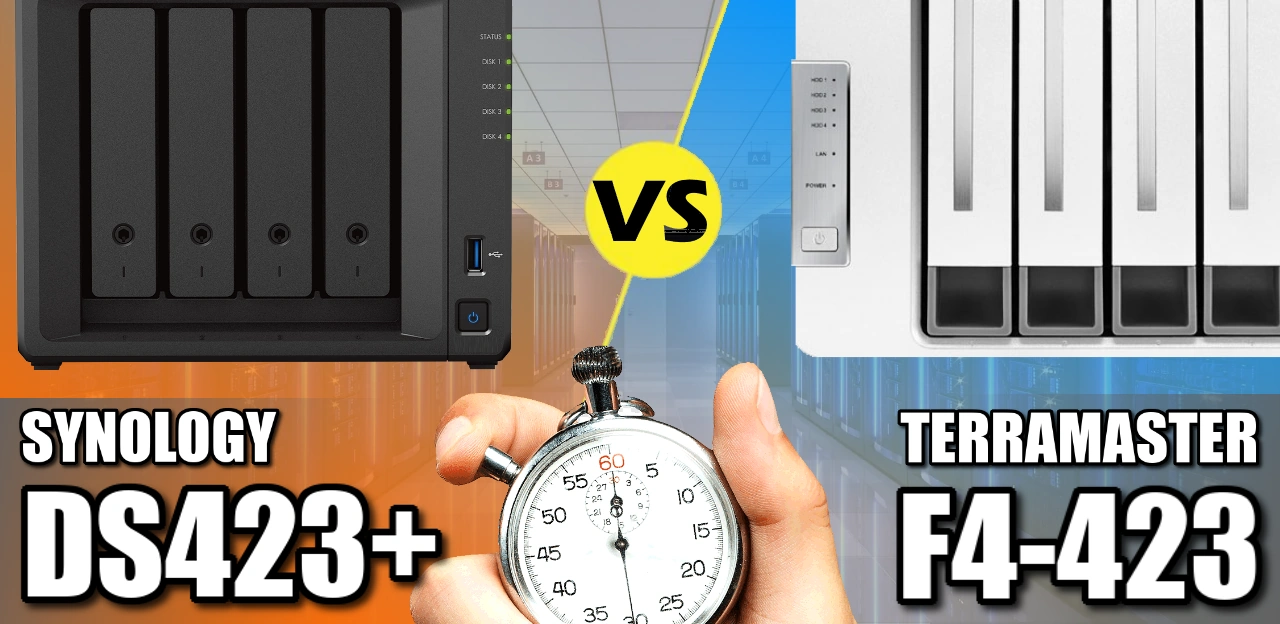
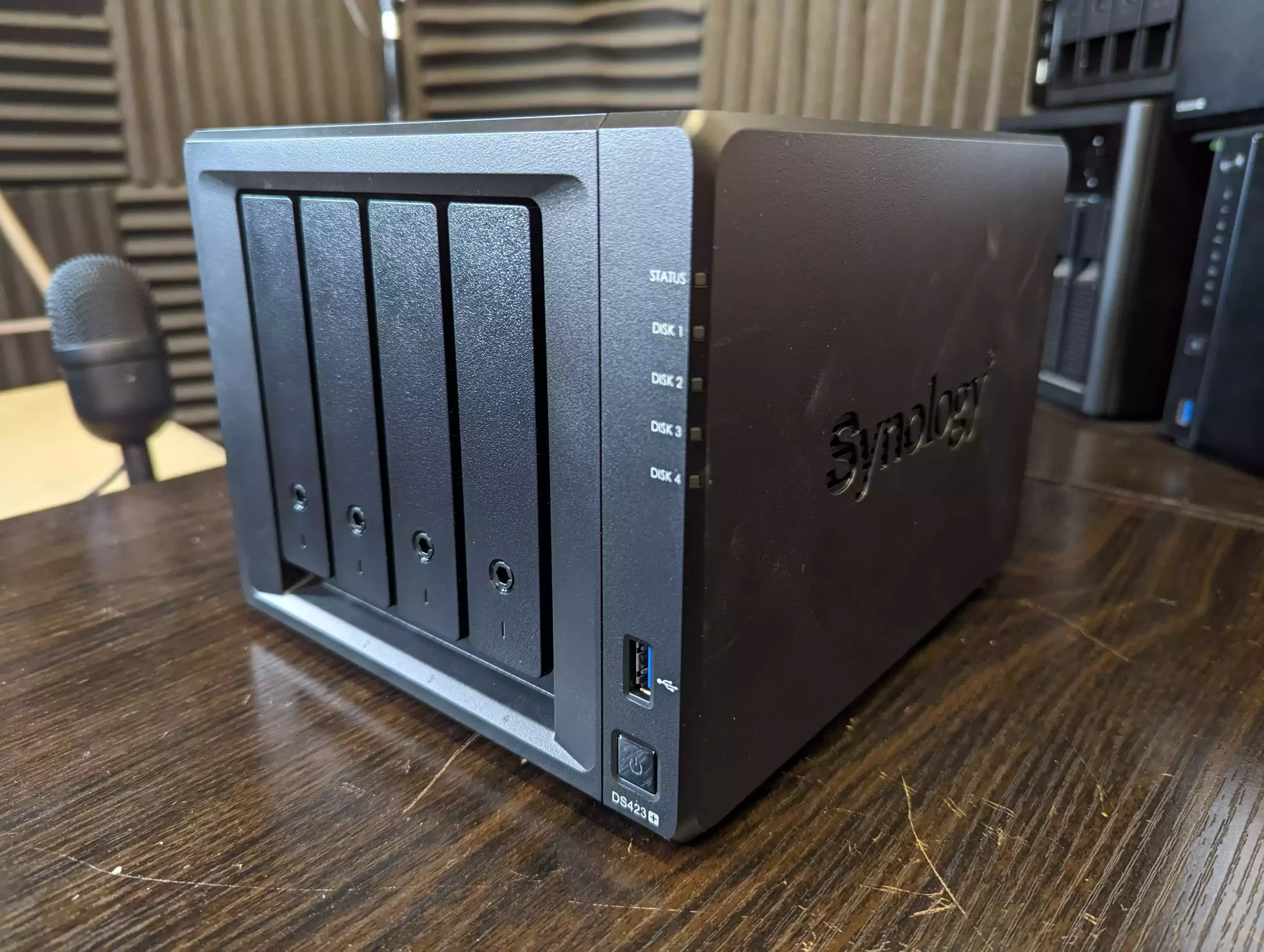
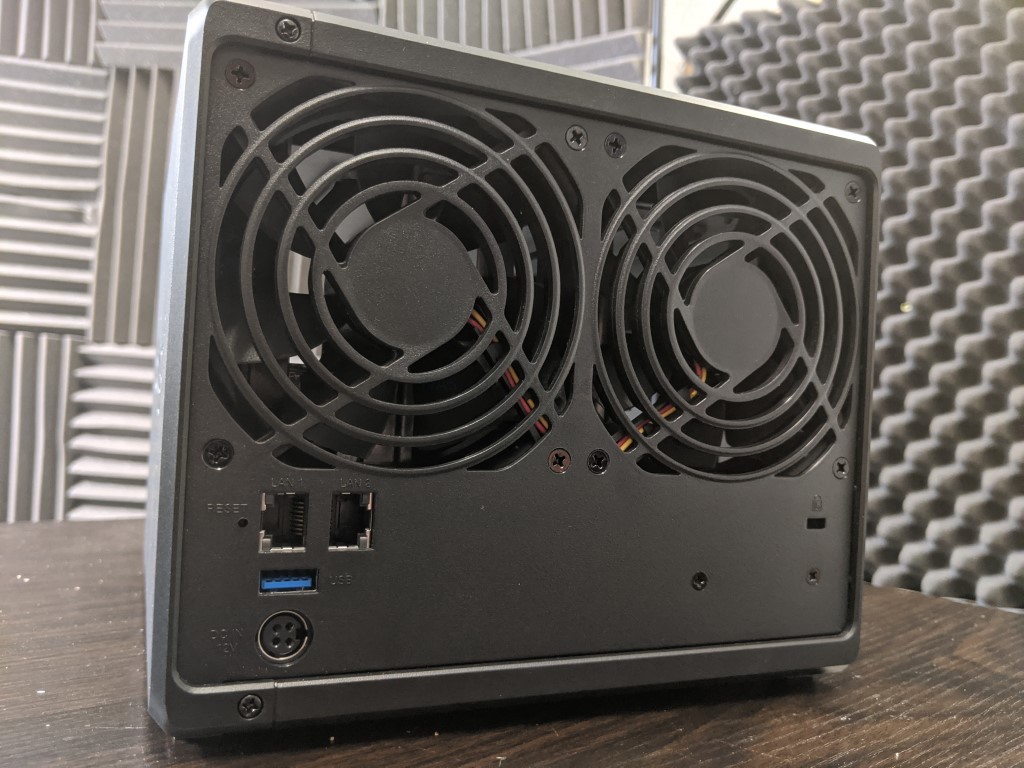
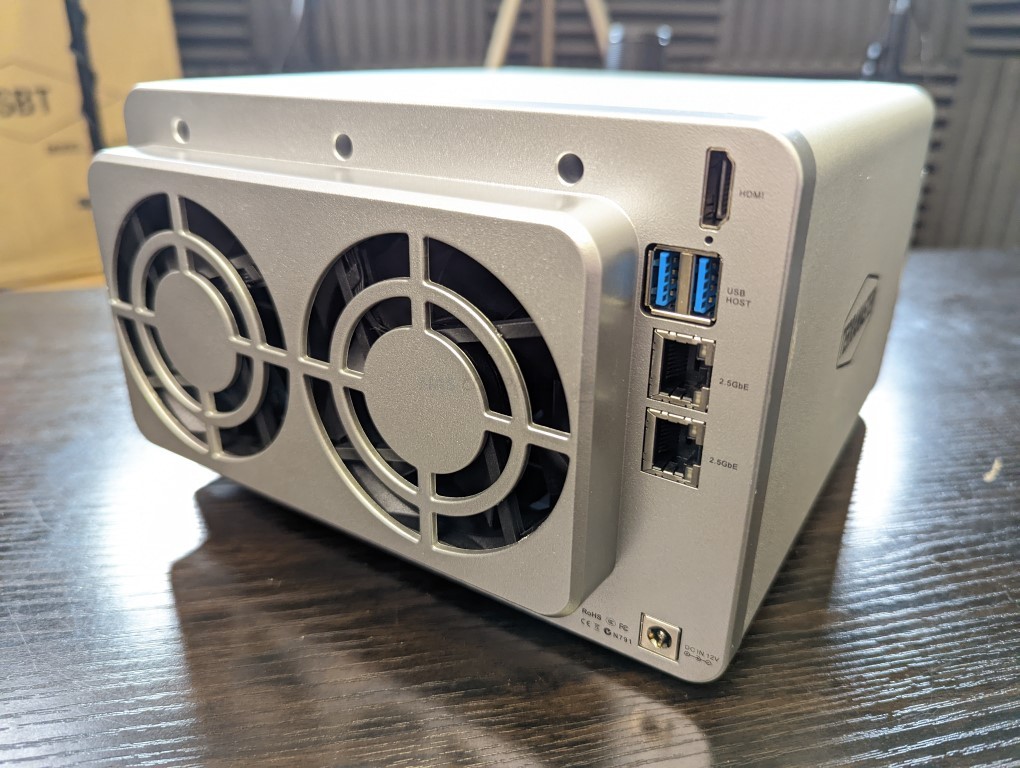
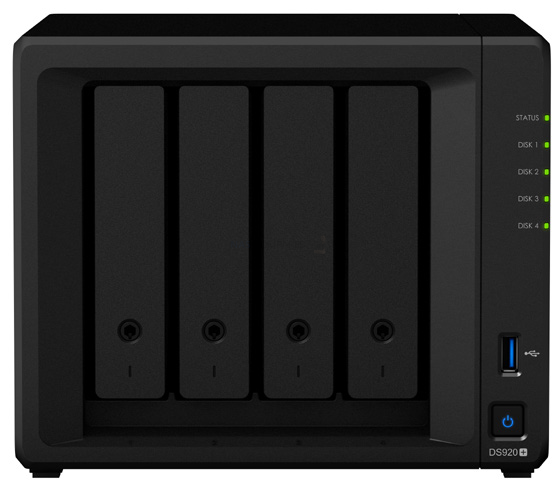
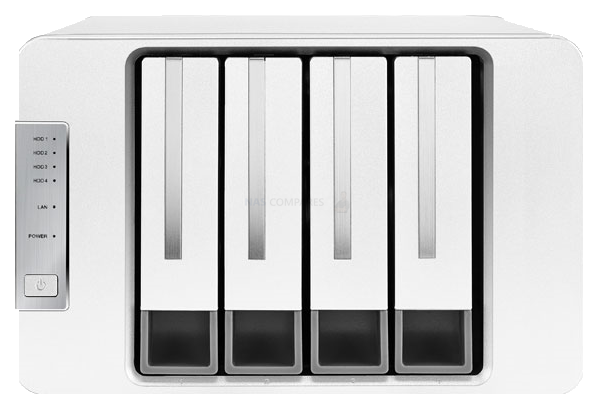




This setup is rather nuts than useful!
First: Dont install the OS on freaking 4TB, those drives are for your Data. What a huge waste
second: You can use every port for booting, but its smart to keep the front USB free for Keyboard/Mouse or a USB-Backup drive etc.
third: Use the USB inside as OS. You have at least 5yrs before a pendrive USB wears off. You can also use a usb-to-sata and use a sata drive. (In the Terramaster-Case use a 99degree Angle USB-Cable as there is tiny space)
REPLY ON YOUTUBE
This is really a shitty video. Did exactly what described. Terramaster F2-423. Trunas installed on 32gb bootdisk with rufus. Tried diverse bootmethods.. Booting from nvme. Boot tos disabled in bios. But the system never booted in TNAS. It stucks in de TNAS menu. Reinstalled the original TOS usb disk. After changing de bootdisk to BIOS, the system boots into the shell.
REPLY ON YOUTUBE
Terranas boots up in GRUB and not TRUENAS. Removed de usb stick. Changed bootorder to NVMSE2. But keeps booting in Grub and keeps saying Tos boot USB storage not found. This is not as expected. Really disappointing.
REPLY ON YOUTUBE
Hi – thanks for the great video, it helped me decide to get this F8 SSD Plus. People are mentioning the slow RAID rebuild speed: perhaps it a new setting, but in the TOS 6.0 interface under Storage Pool settings (gear icon top right), you can set a custom speed. I set the minimum to 512MB/sec and the max to 800MB/sec, and after logging in via SSH and running “watch cat /proc/mdstat” was able to see this running around 800MB/sec! Not sure where else to share this so please spread the word and save people hours ????
REPLY ON YOUTUBE
Bought a F4-423 off of amazon. Died in less than 6hrs of use. – NO POST – Nothing. Wrote comprehensive review and posted it on amazon. They approved the review, and then they later removed it without reason; proably cause i was letting everyone know i bought a synology to replace it and its been rock solid. Still censoring poor reviews BAD sign. Look reviews on sites that dont censor IE newegg and others. DO NOT TRUST Amazon review matrix.
REPLY ON YOUTUBE
Can I do the same for TrueNAS Scale? Do you have a video for it? Thanks
REPLY ON YOUTUBE
Thank you for this detailed overview
REPLY ON YOUTUBE
So basically a Linux OS lol
REPLY ON YOUTUBE
Please don’t spin the mouse pointer like that!!!!!!!!!!!!!!!!!!!!!!!!!!!!
REPLY ON YOUTUBE
Does TOS5 support NTFS in terms of external USB 14TB HDD connection?
REPLY ON YOUTUBE
Hello !
Lately I’ve been carefully following your channel and blog about NAS systems.
At this time, the question arose of choosing between Synology DS423+ or Terramaster F4-423 NAS.
Before your reviews, I checked a lot of information about Terramaster and just like you, I came to the conclusion that Terramaster is much better in hardware than Synology.
Until the moment when the need arose to use something more compact and less energy-consuming than a PC with True Nas installed, I did not explore the market for compact NAS systems.
With Terramaster, new horizons and opportunities have opened up.
Great video review!
Still, I discovered one point in the video: it is not necessary to insert the installation/bootable USB flash drive from TrueNAS inside the Terramaster.
We only need it at the stage of system installation. Upon completion of the installation, it is advisable to remove the USB flash drive and put it aside so as not to occupy the USB ports and not create confusion in the boot devices.
TrueNAS can install the system on a separate disk or soft raid (if you select 2 identical disks during installation – for example, 2 SSDs)
Therefore, keeping the TrueNAS installation flash drive in the device simply does not make sense.
I will also say that if you install the system on a disk, it can no longer be used as part of a RAID array – RAID1 mirror, for example – this is at least what I know from personal experience.
To avoid such problems and inappropriate use of the disk (of course, you can separate the partition with the system and use the free space, but RAID will still not be available for creation), you need to install TrueNas on a separate physical disk – an SSD, for example, or better yet, 2 disks in software RAID mirror.
That way, if the system drive fails, our data in the storage pool will not be affected.
This still makes sense for replacing disks – the system remains the same as it was, but we only change the disks and create an array from them. All settings will be saved.
Perhaps I missed something or I don’t know from either side the whole TrueNas mechanism, but the general concept is this: the disk is separate for the system and the disks for the data pool are separate.
Thanks for the review! Good luck!
REPLY ON YOUTUBE
What is the reason to replace Terramaster’s OS with TrueNas? Does TrueNas provide better features? Is there any comparison?
REPLY ON YOUTUBE
I bought DS423+ after comparison reviews from your channel, and watched this video while still waiting for it to arrive. Great job! Is someone at the door? it’s my NAS arrived!
REPLY ON YOUTUBE
hope you don’t want to encrypt your zfs volumes, performance is so bad on f4-423 🙁
REPLY ON YOUTUBE
I’m running this on a F2-423 and I completed the hardware process. When I did the bootup however, I got a message ‘grub_fshelp_find_file_lookup’ not found…any idea what I did wrong?
REPLY ON YOUTUBE
Had this on in the background over a couple of days. This is the comment you requested — I made it to the end! =D
It’s definitely not in the budget for me yet, but I’m dreaming about a NAS in my setup in the future!
REPLY ON YOUTUBE
Question: would you be able to leave your Terramaster at home and go on a business trip and access it from a different country?
I have a team of editors in different countries. Can they access the files online? I don’t want them to access all the files, just the ones I want them to. Is there a way to limit their visibility?
Looking forward to your answer. Thank you
REPLY ON YOUTUBE
Would it not be advantageous to use the Internal USB socket to install TrueNAS on? Would be a sweet way to free up the NVMe slot for maybe a cache.
REPLY ON YOUTUBE
Got a F4-423 for only 400€ on prime day, cant wait to set it up, it sounds like a holy grail for plex by price/performance/energy consumption
REPLY ON YOUTUBE
Even it is old video, still it helped me to make decision , which one to go for. (no spoilers 🙂 )
REPLY ON YOUTUBE
Wow, that sounds total surveillance by terramaster. That is a double no, no. So terramaster is only an option with any other NAS software. Sad.
REPLY ON YOUTUBE
If the USB was used for installation only, what’s the purpose of keeping that inside???
REPLY ON YOUTUBE
I am looking at getting the F4-423 and x4 16TB in one go and want to run TRUNAS rather than the original OS from the start. What size of nvme would you recommend for the terramaster running for TRUNAS? I am thinking of WD Red SN700 1TB drives or Intel Optane nvme H10 for durability, one for OS and one for cache or would you recommend a different NVME config or brands? Later i think i would like to setup a second identical system as a second tier of backup, but the debit card can only take so much wear at one time after all.
REPLY ON YOUTUBE
Is this a better idea than building a DIY server? What are the pros and cons. That would be a good video… but also a fantastic comment reply.
REPLY ON YOUTUBE
Thank you for this incredibly information packed summary. I will be setting up my first NAS (Terramaster F2-422) next weekend, when the drives arrive. I consider myself to have a good grasp of general computing and network functions and processes. Having said that, due to the sheer speed at which this video tries to cover every conceivable part of the software, I’m going to have to watch it several times. Also for a beginner video, the assumed knowledge of acronyms and other jargon is extremely high, leaving me quite lost on several occasions. I appreciate the work that must go into these videos, and thank you for that. But by way of feedback, this is incredibly overwhelming.
REPLY ON YOUTUBE
i did watch the whole video
REPLY ON YOUTUBE
Is it just me or does it seem like Terramaster is doing “Synology” better than Synology? TOS seems a lot like the best parts of DSM without as much of the weird quirks DSM has picked up over the years. And the hardware generally costs less. I realize there might not be quite as much polish here overall, but I’d consider this over Synology for my next NAS just for having AI object recognition in photos (c’mon Synology Photos!) And I prefer the overall aesthetic and colour scheme of TOS over DSM. The grey accenting is preferable over everything being blindingly white.
REPLY ON YOUTUBE
First..thanx for the great and clearing explanations in your mooie. Second ..i doet know why you say that the TM has a dated case and looks. I think it looks fantastic and modern. The silver is great. Black casings i dont like. I want to use a nas for only one thing. To put on all my movies tv shows and music together on one device, and being able to watch and listen on all my pc’s and tablet througout the house. Wired throug my 2.5 gig network. So the TM IS a great and less expencive alternatieve. Only the size of the case could be a little smaller. But that is not a deal reader for me. Thanks for your great channel.
REPLY ON YOUTUBE
Thanks!!!
REPLY ON YOUTUBE
Great content! Thanks for your time and experience!
REPLY ON YOUTUBE
I’ve seen reports of using the read-write cache option causing the entire raid volume to crash if an ssd fails, so I’m personally going to be sticking with the read cache only.
REPLY ON YOUTUBE
Hola, compre el NAD F2-210 de terramaster, es posible instalar este sistema en ese NAS o es muy limitado?
REPLY ON YOUTUBE
How this doesn’t have more likes is unjust. He covers so much and shows great examples. He also has time marks for reference. Great resource! Keep up the good work, would give you more likes if I could.
REPLY ON YOUTUBE
One thing I wish sonology would do especially further backup program is allow you to back up to a networked windows pool drive aka the NAS sync with networked multipooled Windows drive giving you to a form of backup even if you cannot see the data on the Windows pool that be fine if it was just an encrypted image or better yet allow the damn system to read Windows pool drives…. You’re plugging a USB hub with all your USB drives the nas makes its own virtual pool out of those drives and then it backs up just in case there’s nobody has a single 60 terabyte drive …. The fact that most people are coming from multiple hard drives externally to Nas and can’t use those multiple drives as a single pool backup is annoying especially when there’s hard drive crashes or or anything like that at least you’d have a personal backup I didn’t even pay 10-15 dollars per drive one time fee to make a pool for image backup
I literally had to Jerry rig using always-sync to back up the entire NAS drive on a 9 hard drive pool on the Windows side
REPLY ON YOUTUBE
Insert the biggest thing I hate about Synology outside of their “hard drive requirements” (if the damn hard drive says Nas supported then it should just work you shouldn’t need a specific hard drive) is them telling you where to put your media or files for specific programs they own you should be able to tell the programs just like in Plex where the files are where you wanting to put the files and have one way think as an option with no deletion
REPLY ON YOUTUBE
I personally find it difficult still for a novice user especially for making user accounts … Aka having public and private folders for individuals in a group setting (you can’t have both) we’re in the group setting everyone has the rules AKA right and no delete for public folder and the ability for only individual users in that group to only see their private folder and not everyone else’s
Aka private “Jon” public “all” private “Sarah”
John can still see Sarah’s folder
Because I haven’t nested in an outside folder public and an outside folder private where all their names are in the private folder so it’s nice and organized
But everyone can still see everyone’s folder I’d love to have it so that you can easily isolate nested folders
REPLY ON YOUTUBE
One application they should make is a network photo slideshow screen saver picture frame app with dslp and outside network
REPLY ON YOUTUBE
The one and only thing I don’t like about Synology multimedia apps or drive apps…. Is they TELL you where to put your media AND GENERALLY HAVE TWO-WAY SINK AS DEFAULT
Most users are going to have a plexa library that they’ve probably customized and should customize in one bulk “media folder” and then break it down within…. If you do stuff like that for all your multimedia they’re native apps don’t work you have to have it where they want it…. Same with sync you have to have it where they want it and it’s only sync … Me personally I want one-way sink data goes on the NAS … You can delete it off the phone or computer and that won’t transfer over…. They have improved the drive application but I still have to improve video photo and the other ones to be one way and for us to control the locations multiple or single nested location I don’t want to be told or you got to have it in the ” home /user /names/ photo/ to have the photo application work
NO I want to have it in plex media / photos/ cell phone 01/
REPLY ON YOUTUBE
why do I need raid 1 on the ssd cache? It doesn’t matter if the data is gone on the cache if one ssd fails. The data is stored on the HDD after a Data is altered in the read/write cache. or is written again from the HDD when a new SSD is added. So that makes no sense. Raid 0 would be better in this case.
REPLY ON YOUTUBE
Can we get a wordpress video on how to put a website live with port forwarding??
REPLY ON YOUTUBE
Thank you for this Video!
REPLY ON YOUTUBE
I forward to see Firewall review TOS 5 but i don’t see deep review for this. Please make it more deep for this future next time.
REPLY ON YOUTUBE
Were the trash can ??? Please. On tos 4 there was
REPLY ON YOUTUBE
Funny how that Security Advisor isn’t barking at you for having the standard 5000 and 5001 ports in use. Mine’s been yelling at me 24/7 about it.
REPLY ON YOUTUBE
That really is an in-depth and thorough review. I’ve had the DS1621+ for about a year and you’ve helped explain what some of the apps actually do. Thank you.
As a photographer using Lightroom to manage my my photos, I still cannot understand why I need Synology Photos or S Video to manage them?
REPLY ON YOUTUBE
Thank you for the detailed review. I am interestedin buying a new Synology Nas (920+) and i own an old XP 32 bit PC do you think there will be any issues about compatibility from Win XP 32 bit to the DSM 7.1 Synology NAs, in that case does any workaround exist?
REPLY ON YOUTUBE
The TerraMaster is basically an Intel NUC so you can install almost any OS to it. A great alternative to a custom DIY-NAS if you want the smallest footprint.
REPLY ON YOUTUBE
I kind of disagree with the Point of the Multimedia Software. I think the NAS-producers should stop developing their own Multimedia-Software. Why is this? First of all it is not their key competence but an unwanted step-child. For example the “best software NAS” Synology. The Android App for the Video Station is updated about/less than once a year followed by a second fix release. And it is not a rock stable App having tons of features. And the NAS-specific software misses the Plugins/addons of a/the community. They have no chance to get as good as multimedia apps like Emby, KODi, Plex or Jellyfin. I think it would be better if the NAS-producers would look out for a good open source Multimedia Software and contribute. They should implement a good integration in the NAS system. That would be a better choice. Just my opinion.
REPLY ON YOUTUBE
Bedankt
REPLY ON YOUTUBE
I’m the one who watched the whole thing! And some bits twice. Very helpful in trying to decide between a Synology DS923+ and Qnap TS464. Synology seems to have the upper hand software-wise which I suspect carries more weight for a home user than the superior hardware of the Qnap? Thank you for providing this extensive review!
REPLY ON YOUTUBE
Hi greats from Ecuador – South America. ¿Can I change the OS from F2-210?
REPLY ON YOUTUBE
Awsome information. Now please a similar video on Qnap. I cant make up my mind as I need both photo management and video surveillance. It seems like Qnap and Synology takes 1 point each.
REPLY ON YOUTUBE
Jellyfin?!!! Most channels that review media server software, either only deep-dive their preferred offering, or only give an overview compression of the field. If someone like you, who can give the same enthusiasm creating two videos deep-diving two NASs that only differ by a drive bay, puts that into a spin-off series on a topic that is close to a large chunk of your demographic, that would be a real treat.
REPLY ON YOUTUBE
Thks & I just watched it again & most excellent;
I’m a retired physicist & have no real problem understanding the infinite details.
However my problem is how to keep it simple & stupid (ex: high tier levels of simplicity, brevity, encapsulation, etc).
Oh with my goal is to sociably knit-together all my family, relatives, friends, etc on my synology NAS.
Unfortunately I’m going to be Mr Tech support for them. Sooooo I gots-tos keep-it-simple is an understatement & I will be abused (I says anything for family/friends though ;).
REPLY ON YOUTUBE
I’m also only seeing 360. Can’t make out any screen. text
REPLY ON YOUTUBE
You’re a DSM PhD;
I never hear so dense of a presentation of great DSM info & my head is still spinning, thks.
Next-time, you think about having something good to drink every-once in a-while.
REPLY ON YOUTUBE
47:05 Where, When
REPLY ON YOUTUBE
Still only 360p for me
REPLY ON YOUTUBE
Still just in 360p
Hope it will fix soon.
Thx for all the effort!
REPLY ON YOUTUBE
Watched you video from begin to end! Loved the deep dive into DSM, since I am looking into buying a new Synology. Keep up your amazing videos!
REPLY ON YOUTUBE
Nice video. Does anyone know why my USB printer doesn’t work anymore on my Nas Synology ?
REPLY ON YOUTUBE
Thanks for a great video. Really explains what everything is. Recently got my NAS and been already updating hard drives in it. It will mainly be used as a PLEX Server but already considering what i will do when i start upgrading the smaller drives in it. May consider another NAS and use it as strict data back up and maybe a synology Drive / synology Calendar and Email setup. Move my calendar off Google’s stuff. We will see If i do that at some point. Great job again
REPLY ON YOUTUBE
Thank you for all the work you put into this. Very helpful.
REPLY ON YOUTUBE
My English man!!! What a video! Greetings from Greece! I really appreciate your hard work and that content. I have a DS 1520 + and I am not regretting getting it although the new 1522 is out. You have my admiration. Keep up the professional and good work.
REPLY ON YOUTUBE
Why only 360p is showing ????
REPLY ON YOUTUBE
Would it be too much to expect something similar for QTS?
REPLY ON YOUTUBE
Why 360p? Can’t see it clearly.
REPLY ON YOUTUBE
Wow ! What an episode – a full tutorial for everything ! A one stop shop – Thanx Robbie ‘ol mate !
REPLY ON YOUTUBE
Yes was wondering why its. 360p till saw the comments
REPLY ON YOUTUBE
*Note* – Regarding picture quality, this is a BIG video (so many features to cover in a single video) and YouTue can sometimes be a little slow to process HD and 4K uploads, so if this video is in low-quality for you, maybe come back in an hour or so, as YouTube should have finished processing it and have the 4K, 1080p and 720p versions done. Thanks for watching and hope you enjoy the review of Synology DSM 7.1, featuring the DS923+ NAS.
REPLY ON YOUTUBE
Thank you for the vid. I bought a F4-423 the other day and did this. Works great and much better in every way than the old server i was running as a nas.
REPLY ON YOUTUBE
“I hate seagulls”
REPLY ON YOUTUBE
Is it possible to instal truenas from USB to other USB? so i dont have to use m.2 ?
Also, is it worth to get TrueNAS over the TOS 5?
REPLY ON YOUTUBE
CRITICAL NOTE: This isn’t really viable for all Terramaster units!!!! 2/3 into the video a critical point is made. This should only be done on models that allow for a NVMe drive or if you plan to give up a drive bay for a drive to host the TRUENAS OS.
I saw these walk-throughs and went out and bought a F5-422. The F5-422 does not have a NVMe slot. And giving up a drive slot means forgoing the NAS configuration I planned on.
I tried installing TRUENAS on a flash drive (even though it isn’t recommended). The install fails.
I tried installing TRUENAS on the internal flash drive port (I put the ISO file on a different flash drive plugged into an external USB port). Booting off a flash drive mounted externally worked. In fact the external USB ports are super fast (at least 400MB/s) compared to the internal one (40MB/s). So the installer and OS load goes really quickly (but actual OS launching would be slow if this worked since the internal port is slow). Again though, after the OS install happens it tries to read from the assigned OS drive and fails. The install self terminates when it sees this error.
REPLY ON YOUTUBE
Beside of Hardware and simple file share you can’t compare synology with TerraMaster.. The software library on synology is way in front of any other nas company
REPLY ON YOUTUBE
I have a F5-422 and am getting the following when I try to install: “mounting from ufs:/dev/md0.uzip failed with error 2”. It loops like this for about 3 minutes and then dies. The only other oddity is that I have to spam Esc on boot-up and select the USB drive as it insists on going to TOS otherwise. Any suggestions?
REPLY ON YOUTUBE
Feel like the install process should have been to replace the internal USB key with a blank, boot TrueNAS a 2nd USB drive off one of the external USB ports and install it to the internal blank, was there a reason you didn’t do it the way you did? Are the external USB ports non-bootable or something? Like nvme/SSD would be quicker, but can’t imagine HDD would be a lot faster than USB.
REPLY ON YOUTUBE
This is now on my F5-221 and it is pretty good. That TRAID is fantastic!
REPLY ON YOUTUBE
Can anybody confirm the Ram capacity on the F4-423? Docs say 32GB, chip seems to handle 16GB? Anybody tested this? Would like to save a few pennies if 16gb is the limit.
REPLY ON YOUTUBE
Why are you using TrueNAS Core and not the scale version actually ?
REPLY ON YOUTUBE
If I don’t already have a TerraMaster NAS and the intent is to use TrueNAS would there be better alternatives retailing NAS chassis with integrated motherboard/cpu to buy or is it that buying a TerraMaster NAS just for its chassis/mb/cpu is a bargain?
REPLY ON YOUTUBE
I just ventoy now for multiple bootable isos on the same usb sticks instead of Rufus.
REPLY ON YOUTUBE
To your knowledge, does this work with the Terramaster new T series NAS as well or only the F series NAS? Or do you even suggest not using the T series? Thank you in advance!
REPLY ON YOUTUBE
Hello and welcome to my comment. And that is right. I have a quick question. 🙂
I was just wondering why you got a USB drive specifically to fit inside when it didn’t need to stay there. I assumed that the software would be installed on the internal stick and it would remain inside but clearly not.
To save pulling it apart twice (once to swap the drive, and again to remove it), wouldn’t it be easier to remove it the first time and then use an external USB port with any old stick we find kicking about the place? I assume there’s a specific reason why the internal USB port is the best (or only) choice here but I may have missed it. I was just thinking about missing a step and halving the potential for damage by only ripping the thing to bits one time.
Also, a second question if I may: I was under the impression that TrueNAS required (or advised) the use of ECC memory. I’m not sure that Terramaster supports it, and the memory you selected didn’t appear to be ECC. I haven’t looked into either yet, by the way. Any thoughts on that?
That’s all from me. I didn’t realise that was even possible, and I may consider getting a Terramaster NAS for use as a low-powered home Linux server on the back of your presentation. Thanks a lot for the video.
REPLY ON YOUTUBE
Like yousaid over and over again best commercial NAS is QNAP TS-h973AX-32G period.
REPLY ON YOUTUBE
TOS 5 was a major flop so I’ll be using true nas core
REPLY ON YOUTUBE
I’d Love to see this on some of their rack mount models like the U4-111 or U4-423
REPLY ON YOUTUBE
Are you going to do a tutorial for getting Unraid on the TM too? Really interested in a T9 or T12 and if it can use Unraid, it’s an absolute deal for me.
REPLY ON YOUTUBE
I’d like Terramaster would be all black with side silver TerraMaster logo.
REPLY ON YOUTUBE
This does create the ultimate zfs NAS in my opinion. Really thinking to replace my very outdated Qnap (839-pro) with this setup.
REPLY ON YOUTUBE
Why not remove the fan connector from the mainboard before you install the USB stick? that could make things easier. I think.
REPLY ON YOUTUBE
Isn’t Terramaster one of the companies that has been hit with ransomware attacks relatively recently? Does installing TruNAS, instead of using the factory-installed OS, help to mitigate these attacks?
REPLY ON YOUTUBE
Quick question: it’s a bit off topic to the video but it’s regarding replacing a wifi card in a laptop (I was watching a video from 2 months ago on this topic):
Question: what would I do if the wifi card I’m replacing is the exact same model as the one I had? What would I do in terms of installing drivers?
I have an Acer Nitro 5 AN517-51 with an Intel Ax200 wifi 6 card in my system. Recently I was doing a fan replacement and repaste of the heat sink, and I accidentally pulled the aux cable and the aux connector attached to my wifi card came off while trying to reattach the wire.
I wasn’t sure if I should upgrade to AX210 (cause I’m scared of it not working, then I have no working laptop at all), so I was wondering whether I could just do a straight swap of AX200 for AX200 and would that require any driver installation beforehand, if the card is the same model as the old…?
Or would upgrading to AX210 be better all round as a solution. I just want the least painful and quickest experience, which is why I thought AX200 for AX200 may be as I may not need to fiddle with driver updates
REPLY ON YOUTUBE
Will something like this work on a asustor lockerstor? ADM is half baked.
BTW your channel is awesome and crazy helpful.
REPLY ON YOUTUBE
Alles sehr schön. Aber zuerst zusammen die Nummern 10 und 1. Eine verwohn.online Brünette und eine anderec Blondine. Es wäre unfair, wenn ich 4 wählen würde
REPLY ON YOUTUBE
Ahh of course, when you don’t really know:
You do not need a display output!
Simply install on a PC and then move to this device, boot and simply find the IP address.
Do not install on a regular USB drive as it will fail sooner or later. Spend a little more for an USB SSD, NVMe or a high endurance USB drive.
Just make sure your device has an Intel CPU and NOT an ARM CPU!
REPLY ON YOUTUBE
16:50 I don’t think we were meant to see that.
REPLY ON YOUTUBE
great review.
was very excited about TRAID but disappointed in how incredibly SLOW it is to create, did you notice this in any testing?
REPLY ON YOUTUBE
What do you think of TerraMaster T6-423 as a Plex Server ? In America it’s $699 way lower cost than synology or Qnap. Let us know thanks again, keep up the great work!!
REPLY ON YOUTUBE
Where is dedup?
REPLY ON YOUTUBE
hello sir how are you i have a qnap ts-53b but i feel the device is very slow and the system is slow
REPLY ON YOUTUBE
With all the QNAP exploits lately, Terramaster creating a way to remotely access the server is a hard pass.
REPLY ON YOUTUBE
Hated it, not a improvement. Went back to the old version. Had nothing but issues. Of course Tetramaster blamed me not Thier OS. Maybe try it later when it’s been fixed.
REPLY ON YOUTUBE
Having read some of the TerraMaster forums over the TOS5 update I think I’ll be skipping on this one and going after an Asustor Lockerstor 4 instead.
REPLY ON YOUTUBE
For the price, hardware, and lack of hardware restrictions… Terramaster might end up being the easier sell over Synology. Depends on stuff like available memory, expandability, ECC or not, nvme cache or not. Might check back in on TM down the line if I don’t like my unraid adventures.
REPLY ON YOUTUBE
Hai anna iam Nagendar Anna na age 42 vor.monster qualification m.l.t medical lab techniciang ,Srpt lo jobs unte cheppagalaru anna.with govt Jobs
REPLY ON YOUTUBE
JEEEEZ!
I am only liking and commenting to defeat the YouTube algorithms. I am not the target audience for the Terramasster.
REPLY ON YOUTUBE
Connecting a NAS directly to the internet, geez. I’ve also come to realize that no matter how intuitive software is the best course is to read the documentation and plan the installation. The read twice, install once method, per se.
REPLY ON YOUTUBE
I think we have a winner
REPLY ON YOUTUBE
I just bought the F4-423 – never used TOS and went straight to unraid … changed the USB Stick in the unit to a unraid trial one. Changed some Bios-settings on the first boot. Put 2x16GB in – they run @ 2999 MHz + 2xM.2 as cache pool (BTRFS-Raid1). 2x18TB-Disks (xls) just finished parity after ~21h. 2 more disks are coming. Out of the box everything worked except CPU-temps readout…but i am investigating (disk and M.2 temps are working). Now busy with setting up the rest. Let’s see how stable the system is after some weeks. I am testing now transfer speeds, rebuilding, installing containers….
So yes…500 USD for a small motherboard, processor plus backplane, 2xM.2 slots and 2×2,5GbE is a lot…but if you start at “nothing” and consider the ease of first setup + getting all components in these times…its cheap and in a very small external package + sipping power. CPU usage was 8-14% during Paritycheck @280MB/s…now ~3-4% ideling in WebGui. It was a promising start… but now i am of learning more and more things about unraid…one big plus so far is the community. I will test this for one month and decide to move it in production.
I came from a DS107+ and later a DS414 that will be EOL soon – so I know what i need in terms of size and power. Synology was very good for many years of service with little to no hickups – but synologys more and more walled garden are not my thing. So it was time to change horses since i am on linux/windows anyway. There was also no point in waiting for DS422/423 whenever that would come out. Now was the time.
REPLY ON YOUTUBE
I think the Terramaster is going to be my next NAS. It’s already cheaper than the DS920+ so lord knows how much more the 922 will be when (if?) it’s ever released. 2×2.5GBps ports, better memory. Better processor. Better onboard graphics. Just 2 grey clouds; TOS5 release date and HD compatibility… I will say that the TOS5 live demo looks a lot like DSM in some places…
REPLY ON YOUTUBE
Hi @Robbie i got my DS920+ in june 2021 for £404.39 Good Price but its normaly a lot more i dont know why as they are not worth the money and as for a DS922+ or what ever the next one will be and will you have to get there memory and there drives to get your warranty this is not legal in most parts of the usa but for me its just immoral and a shady way to do Business as for the m.2`s not being able to use as raw storage .. end of rant 🙂
REPLY ON YOUTUBE
Have you done the DS920+ vs. the Asusstor Lockerstor 4 (AS6604T)?
REPLY ON YOUTUBE
I wrote to you previously about Synology vs QNAP tp replace an old Drobo. My needs are not immense but I need an enjoyable environment without the hard workout of the OS. I have just bought a 920+ on Friday and am having a great time going through the learning process. I am a software hobbit and DSM7.1 is keeping me happily occupied for some time to come. I did have a look at the 423 but the TOS with TRAID is still beta so that is not in the consideration. Thank you for your wonderful videos.
REPLY ON YOUTUBE
You love seagulls, I am sure of it 🙂 🙂
REPLY ON YOUTUBE
Thanks. I’m still strongly leaning towards the 1520+
REPLY ON YOUTUBE
Great and very timely video.
REPLY ON YOUTUBE
Don’t know if I missed it, but any comments on the noise between the units?
REPLY ON YOUTUBE
Great comparison, as always
REPLY ON YOUTUBE
????????????????????????
REPLY ON YOUTUBE
????????????????????????
REPLY ON YOUTUBE
Hello!
REPLY ON YOUTUBE